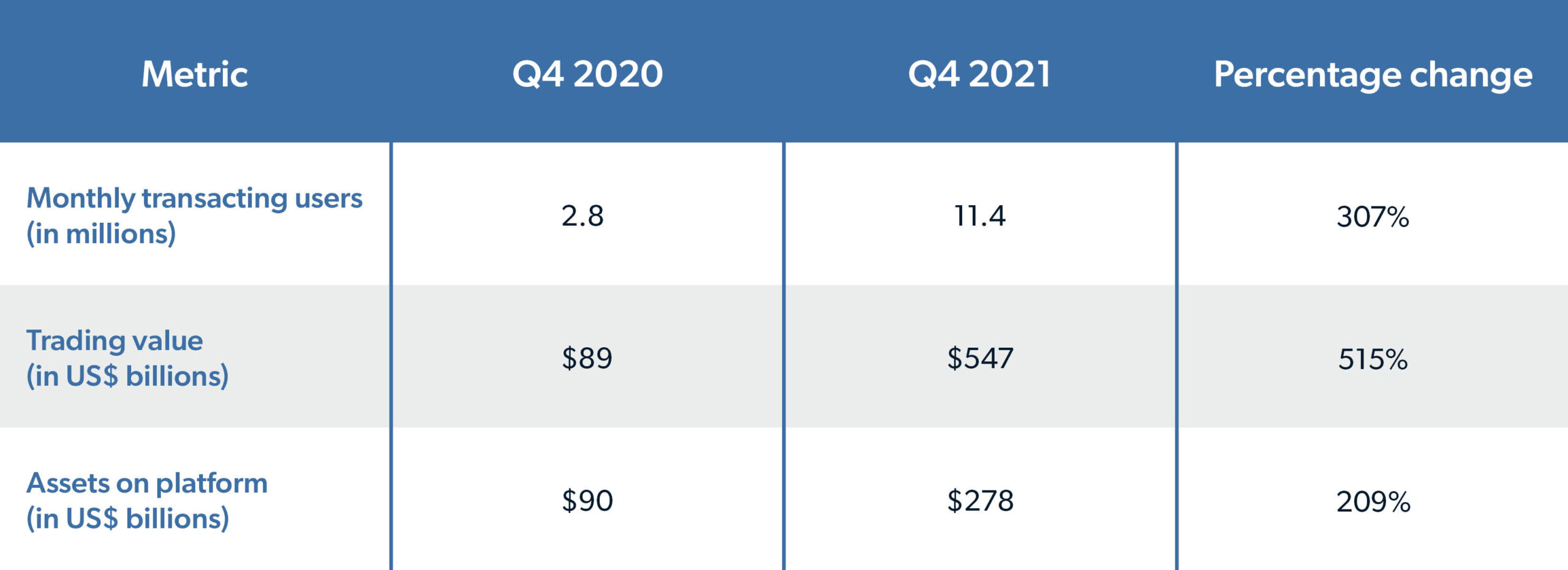 With total global digital asset market capitalization growing from roughly US$20 billion as of year-end 2016 to nearly US$3 trillion in November 2021, digital assets have found their place in certain private and institutional clients’ balance sheets—largely outside the purview of classic financial advisory relationships.
With total global digital asset market capitalization growing from roughly US$20 billion as of year-end 2016 to nearly US$3 trillion in November 2021, digital assets have found their place in certain private and institutional clients’ balance sheets—largely outside the purview of classic financial advisory relationships.
In fact, activity at Coinbase, one of the largest digital asset exchanges in the world, swelled during 2021, as monthly users, trading, and total assets on the platform each grew exponentially, as seen in Table A below.
Table A: Coinbase Year Over Year Growth

Interestingly, total global market cap dropped by nearly half to $US1.6 trillion during Q1 2022—exposing, rather remarkably and vividly, the wide scope of risks associated with digital assets (e.g., client suitability, custody, market manipulation, KYC and AML, exchange, credit, etc.), and the potential role public and private stakeholders up and down the value chain can play with respect to mitigating said risks. Wealth management firms are not sitting idly by. In fact, the feasibility of adopting some sort of digital asset capability or product offering continues to percolate.
The growth of digital assets thus far in the United States is remarkable, particularly since it occurred in an environment without any federal regulatory framework. Absent federal regulatory guidance, fiduciary-oriented wealth managers, legally obligated to advise in the best interests of their clients, have been unable, and largely unwilling, to join in. Thankfully, clarity is on the horizon.
March 2022 saw two digital-asset-focused regulatory developments, both of which will provide much desired direction for participants in the wealth management ecosystem. Although each regulation is in early stages, not yet set policy, their collective contents can serve as a signal to market participants how to move forward in the near term:
- The Biden Administration recently issued an executive order (“EO”) mandating a government response to developing a regulatory approach for digital assets (full text here, fact sheet here). The EO directs agencies across the federal bureaucracy to comprehensively evaluate the risks (and mitigation thereof), benefits, and required infrastructure of and for digital assets.
- Soon after the EO was released, Senators Kirsten Gillibrand, D-N.Y., and Cynthia Lummis, R-Wyo., revealed they are working on a bipartisan regulatory framework for digital assets. The work is focused primarily on consumer protection and certainty for markets, prescribing specific responsibilities for the SEC and CTFC, and clarifying the taxation of digital assets. Legislative text is anticipated to be introduced by mid-2022, with a potential vote by the end of the calendar year 2022.
These developments portend regulatory clarity for wealth managers, custodians, and other parties within the financial services industry. The EO will clarify how best to mitigate key fraud and illicit finance-related risks, while the legislation will prescribe specific oversight roles for the SEC and the CFTC.
Once settled, Aite-Novarica Group expects CFP and CFA board-approved education to become available to certain advisors, and digital assets will become integrated into certain classic portfolio risk and management solutions (likely in partnership with digital asset infrastructure already being built).
For deeper analysis of these regulatory developments, as well as how wealth managers should sate investor demand in the intervening period, see Wally Okby’s and my latest report, U.S. Regulatory Developments for Digital Assets: Implications for U.S. Wealth Managers.